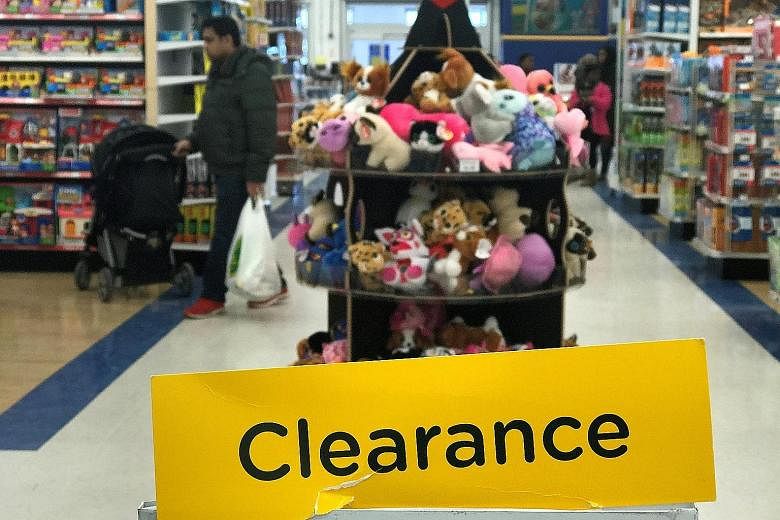There's trouble in toyland, and it started long before Toys 'R' Us went bust.
Sales at the world's three biggest toymakers - Lego, Hasbro and Mattel - slumped during the crucial 2017 holiday season, and the outlook for this year isn't much better.
Children are tiring of movie-linked playthings - such as Lego's Batman and Hasbro's Star Wars line-ups - that used to be reliable moneymakers. Venerable brands such as Mattel's Barbie and American Girl are showing their age.
Many shoppers are trading down to collectible figurines such as L.O.L. Surprise dolls and Hatchimals stuffed animals that can retail for less than US$10 (S$13). And the big toymakers don't have much skin in the fast-growing mobile-games sector, which already commands 20 per cent of the US$187 billion global toys and games market, according to Euromonitor.
What went wrong and how can the Big Three bounce back? The companies focus mainly on saturated North American and European markets, when they should be stepping up efforts in Asia, Latin America and the Middle East, where there's more growth opportunity, according to industry watchers. And the giants need to do a better job of pitching their wares via YouTube, Instagram and other social media, which smaller rivals are using to gain market share.
These problems "are all self-inflicted," says Mr Lutz Muller, president of Klosters Trading, an independent toys consultancy based in Vermont. "Kids are wedded to their smartphones, wedded to social media, and the savvy marketers are using this to promote their products."
Lego on March 6 announced its first revenue decrease in 13 years, after dismissing some 8 per cent of its workforce last year. Hasbro, which ranks just behind Lego in worldwide sales, suffered a 2 per cent fourth-quarter drop, although full-year sales grew 3.8 per cent. Mattel has fallen from global No. 1 to No. 3 after four straight years of revenue decline, including a 12 per cent slump in the last quarter of 2017.
All that, and then on March 15, Toys 'R' Us announced it would shutter all its US and UK stores. The closings could dent Mattel's 2018 sales by as much as 10 per cent, and Hasbro's by up to 5 per cent, Bloomberg Intelligence estimates. Other big-box retailers could take up some of the slack; indeed, Walmart is already the No. 1 US toy retailer. But because non-speciality retailers allocate less shelf space to toys, "they put out what's less risky", focusing on a limited selection of proven hot sellers, says Bloomberg Intelligence analyst Mariam Sherzad.
That could jeopardise secondary brands and product innovation. Hasbro, for example, has more than 60 brands. Mattel was planning to launch new products as part of its turnaround effort. "They may have to hold back on that now," Ms Sherzad says.
While toymakers are building their own e-commerce sites, online sales account for less than 16 per cent of the global toys and games market, according to Euromonitor. The shift toward cheap toys is yet another worry.
Mobile gaming is often blamed for toymakers' woes, but the evidence is scant. Children aged eight and under now spend an average of nearly 49 minutes a day in front of a smartphone or tablet, up from five minutes in 2011, according to a 2017 study by Common Sense Media, a non-profit advocacy group. But the study found that increased time spent on mobile devices was offset by an equal decline in TV viewing, so kids' available time to play with traditional toys has not changed.
Some toymakers still have reasons to celebrate. While Mattel and Lego have lost market share in the US, Hasbro's share has grown to nearly 16 per cent from 13 per cent over the past four years, according to Klosters data.
Though sales of its Star Wars toys have been tepid, Hasbro struck gold this year on the hit movie Black Panther. Citing "robust demand", the company says it is ramping up production of action figures and other items linked to the movie's superhero star. Hasbro chief Brian Goldner expects movie-linked toys will continue to drive sales growth. The company has a strong slate of products tied to new Star Wars and Avengers movies this year, he said in an interview.
Hasbro is also transforming iconic brands such as Monopoly and My Little Pony into mobile games. It took a controlling stake in mobile-games maker Backflip Studios in 2013 and raised its holding to 100 per cent last year. Gaming now accounts for 16 per cent of Hasbro revenues. Lego is stepping up investment to pair its traditional plastic-brick toys with digital technology.
Investors, though, don't seem convinced that the industry is on track for growth.
For all the interest in digital technology and collectibles, more-traditional toys will remain an important part of the market, says Mr Matt Hudak, a toys and games analyst at Euromonitor. "You have millennial parents, having a late-in-life child. They may be more interested in educational toys or just want to share Star Wars with their kids."
BLOOMBERG

